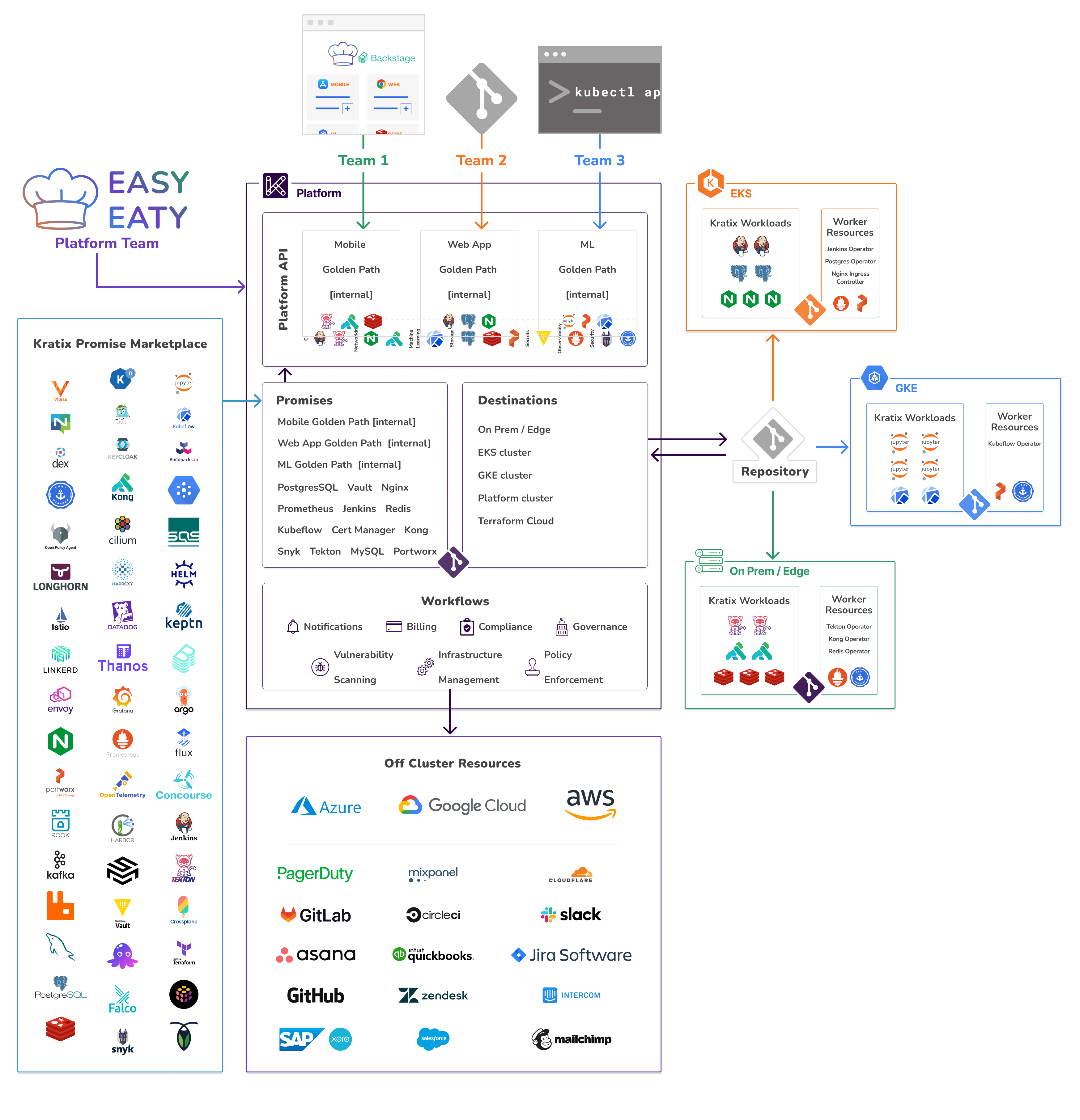Deployment Topology
This page walks through the Kratix deployment topology for the Platform team for our example organisation EasyEaty. The organisation has a number of Application Development teams that all use the Platform to get the services they require.

Kratix platform cluster
The cluster where Kratix is installed is the platform cluster, which is in the centre of the diagram and has the label Platform. This is the cluster that both the Platform team and Application Development teams interface with.
The Platform contains three important elements:
- Platform API: the API for consumers of the platform. In the diagram, the API includes three "internal" APIs and a number of installed APIs.
- Promises: the components authored and/or installed by the platform team to drive the set of services available in the Platform API. See more about Kratix Promises.
- Destinations: a registry of Kratix Worker Destinations. See more about Kratix Destinations.
GitOps State Store
When a Kratix Promise is installed, or when a request for a new Resource comes in to the Platform, Kratix will react by writing workloads to the Destination's State Store.
For example, the State Store in EasyEaty's topology is a Git Repository pictured to the right of the platform cluster. When the Web App Golden Path Promise was installed on the Platform, a set of workloads required to fulfil the Promise was written to that State Store.
Worker Destinations
Kratix Worker Destinations watch and react to changes in the State Store via a GitOps toolkit like FluxCD. Kratix requires at least one Worker Destination to run workloads. All Worker Destinations are registered to the Platform via the Kratix API (see more about Kratix Destinations).
For example, in the diagram there are three Destinations that are exclusively Workers: EKS, GKE, and On Prem / Edge.
Resources
The primary role for these Worker Destinations is to run Resources requested by consumers of the platform.
For example, the EKS Worker has a number of Resources that were requested by Team 2 via the Web App Golden Path Promise: two Resources will be created each with an instance of Jenkins, two instance of PostgreSQL, and three instance of Nginx.
Promise Dependencies
To enable these Resources, each Destination also has a set of Dependencies installed. These Dependencies are baseline capabilities installed on the Destination at the time the Promise is installed on the Platform, and they represent the software that needs to be running prior to any requested Resource.
For example, when the Web App Golden Path Promise was installed on the platform cluster, one of the Dependencies that was immediately installed on the EKS Worker was the Jenkins Operator, which is required before a request for a Jenkins Resource can be fulfilled.
Platform as a Worker
The Platform itself can also be registered as a Destination, which is required if the Platform offers any Compound Promises.
The Web App Golden Path Promise is a Compound Promise because it is composed of three lower-level Promises: Jenkins, PostgreSQL, and Nginx. Compound Promises allow Platform teams to provide higher-level value by combining lower-level Promises available in the Marketplace.
Kratix Marketplace
In order to populate the lower-level offerings in a Platform, Kratix has provided a number of pre-written Promises ready for use. These Promises can be installed on a Platform and configured to meet organisational needs. For example, Kratix offers an off-the-shelf Promise for Jenkins, and the Platform team installed this Promise after configuring properties that are specific to the EasyEaty organisation.
Workflows and Off Kubernetes Resources
Kratix Promises include a concept called Workflows. The Workflows are defined by the Promise author and are executed in the Platform during the Promise lifecycle (for example, when a new Resources is requested from a Promise). Workflows specify a set of actions that should run to fulfil the lifecycle operation, and they encapsulate a number of organisational requirements.
For example, when Team 2 requested the Web App Golden Path Promise, the configure resource Workflow was executed and sent notifications via Slack, set pup an on-call rota on PagerDuty, and created the appropriate tickets in Zendesk.
